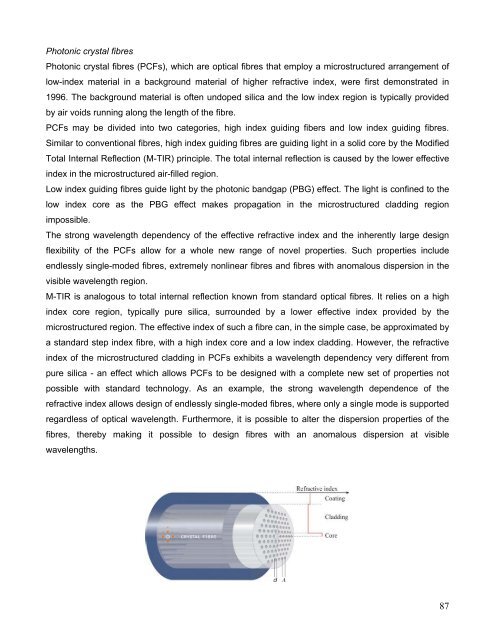Clevertex - Grado Zero Espace Srl
Clevertex - Grado Zero Espace Srl
Clevertex - Grado Zero Espace Srl
You also want an ePaper? Increase the reach of your titles
YUMPU automatically turns print PDFs into web optimized ePapers that Google loves.
Photonic crystal fibres<br />
Photonic crystal fibres (PCFs), which are optical fibres that employ a microstructured arrangement of<br />
low-index material in a background material of higher refractive index, were first demonstrated in<br />
1996. The background material is often undoped silica and the low index region is typically provided<br />
by air voids running along the length of the fibre.<br />
PCFs may be divided into two categories, high index guiding fibers and low index guiding fibres.<br />
Similar to conventional fibres, high index guiding fibres are guiding light in a solid core by the Modified<br />
Total Internal Reflection (M-TIR) principle. The total internal reflection is caused by the lower effective<br />
index in the microstructured air-filled region.<br />
Low index guiding fibres guide light by the photonic bandgap (PBG) effect. The light is confined to the<br />
low index core as the PBG effect makes propagation in the microstructured cladding region<br />
impossible.<br />
The strong wavelength dependency of the effective refractive index and the inherently large design<br />
flexibility of the PCFs allow for a whole new range of novel properties. Such properties include<br />
endlessly single-moded fibres, extremely nonlinear fibres and fibres with anomalous dispersion in the<br />
visible wavelength region.<br />
M-TIR is analogous to total internal reflection known from standard optical fibres. It relies on a high<br />
index core region, typically pure silica, surrounded by a lower effective index provided by the<br />
microstructured region. The effective index of such a fibre can, in the simple case, be approximated by<br />
a standard step index fibre, with a high index core and a low index cladding. However, the refractive<br />
index of the microstructured cladding in PCFs exhibits a wavelength dependency very different from<br />
pure silica - an effect which allows PCFs to be designed with a complete new set of properties not<br />
possible with standard technology. As an example, the strong wavelength dependence of the<br />
refractive index allows design of endlessly single-moded fibres, where only a single mode is supported<br />
regardless of optical wavelength. Furthermore, it is possible to alter the dispersion properties of the<br />
fibres, thereby making it possible to design fibres with an anomalous dispersion at visible<br />
wavelengths.<br />
87

















